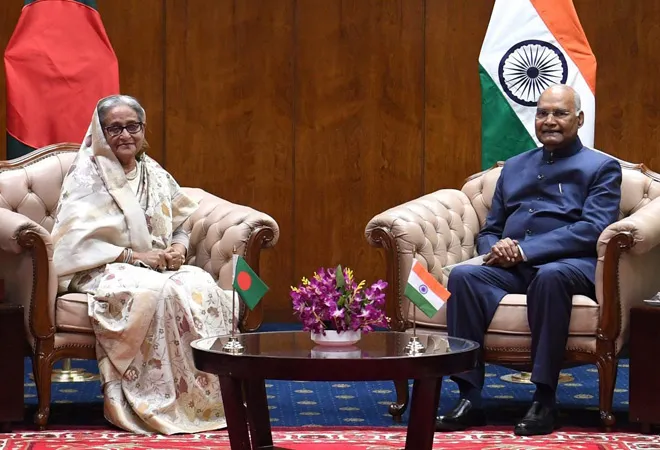
As 2021 draws to a close, the Indian President, Ram Nath Kovind, visited Bangladesh at the invitation of his counterpart, President Abdul Hamid, to be the guest of honour at the 50th Victory Day Celebration in Dhaka. President Kovind’s presence at this occasion is an acknowledgement of the support India had extended to Bangladesh (formerly known as East Pakistan), during its war of liberation against West Pakistan in 1971. It also commemorates the golden jubilee of the establishment of diplomatic relations between the two countries, as 50 years ago, India had been the first to recognise Bangladesh as a separate and independent country. Since then, strategic circumstances have led both countries to emerge as each other’s foreign policy priorities, and the foundational goodwill has only helped strengthen bilateral ties. President Kovind’s visit is, thus, a gesture of recognising Bangladesh’s significance for India, especially as it was his first international travel since the outbreak of the pandemic. On the other side of the border, this gesture was also duly reciprocated, as the Indian President, his family, and an official delegation were the only foreign dignitaries invited to the event.
In keeping with the occasion, the President’s itinerary was designed to pay homage to the memorials of the 1971 war. Therefore, apart from being a guest of honour at the celebrations on National Parade Ground, the three-day state visit from 15-17 December, comprised a visit to the Bangabandhu Memorial Museum on Dhanmondi Road, to pay respect to Bangabandhu Sheikh Mujibur Rahman. It also involved attending another ceremony at the National Parliament’s South Plaza. Recalling India’s support to Bangladesh, President Kovind presented President Hamid with a T-55 tank and a MiG-29 fighter jet that had been used during the Bangladesh Liberation War. These are to be showcased at the National Museum. Furthermore, a delegation of Indian war veterans is also scheduled to visit Dhaka. Certainly, revisiting the bonds of the past, as was the purpose of this diplomatic visit, can be interpreted as an attempt to pave the way for a more collaborative future.
Strategic circumstances have led both countries to emerge as each other’s foreign policy priorities, and the foundational goodwill has only helped strengthen bilateral ties.
For India, which is increasingly trying to ‘Act East’ and put its ‘Neighbourhood First’, Bangladesh as an immediate eastern neighbour, is an important littoral on its eastern seaboard. Presently, the country is also India’s largest trading partner in South Asia. As India tries to indulge in greater cooperation in the South Asian region, to better fulfill its Indo-Pacific aspirations as well as guard against its apprehensions about China’s encroachment in the region, maintaining favourable ties with Bangladesh is critical for the country. India on the other hand is important for Bangladesh, as leveraging ties with it will enhance its economy as well as help in its socio-economic development. Furthermore, as a small country, geographically situated between two Asian giants; China and India, it is in Bangladesh’s interest to nurture a balanced relationship with both, to uphold its neutrality and autonomy. Naturally, both India and Bangladesh have worked to consolidate their partnership for the most part of this half a century old journey. Today, both countries are understood to be each other’s closest strategic ally in the South Asian region, and in a joint statement issued in March 2021, they upheld their partnership as a model for bilateral relations for the entire region.
This bonhomie had been particularly manifested in the past year, when the world was grappling with the COVID crisis. Bangladesh was the first and largest beneficiary of India’s Vaccine Maitri initiative, receiving a total of almost 22.6 million vaccines doses (including grant, commercial as well as COVAX). Similarly, during India’s hour of need, at the peak of the second wave of the pandemic, Bangladesh extended its support through the supply of almost 10,000 vials of Remdisivir, 30,000 PPE kits, and other COVID-related medicines and equipment. The pandemic has, thus, strengthened relations between the two countries, emphasisng their mutual reliance. The President’s visit endorses this amicability.
However, the visit was not only about reaffirming the bonhomie of existing bilateral ties. It was also designed with the purpose to ease some hiccups that have struck a chord of discord in this amicability in recent months. In October, while Bengalis celebrated their biggest festival—Durga Puja, there were several reports from local media in Bangladesh, about attacks on the pandals and idols. Following a report on social media that a copy of the holy Quran was allegedly desecrated at a Durga Puja pandal near Nanuar Dighi lake in Comilla town, violence spread in Chandpur’s Hajiganj, Chattogram’s Banshkhali and Cox’s Bazar's Pekua, causing the death of three people. The police tried to control the situation but were pelted with stones by mobs. Security forces thus intervened and had to fire tear gas shells and rubber bullets to disperse the rioters. Hindu associations across the country viewed the incident as an attack on the minority Hindu community in Muslim-majority Bangladesh. Similar views were also nurtured by Bengali Hindus across the border in West Bengal, India, creating an outlook of bitterness towards the neighbouring country.
Both countries are understood to be each other’s closest strategic ally in the South Asian region, and in a joint statement issued in March 2021, they upheld their partnership as a model for bilateral relations for the entire region.
However, with the government of the two countries committed to nurturing this favourable relationship, the Indian Ministry of External Affairs was quick to respond that the, “government of Bangladesh has reacted promptly to ensure control of the situation, including the deployment of law enforcement machinery.” The Indian mission in Bangladesh was also in close contact with the local authorities over the matter. Presently, the Presidential visit also tried to symbolically ease the tension. President Kovind inaugurated the newly restored temple dedicated to the Hindu Goddess Kali, at Ramna in Dhaka, which had been built in the Mughal era. During the war of 1971, the temple had been destroyed by the Pakistani army, and more than a thousand people had been killed in the incident. The President’s visit certainly sends a message of religious harmony in this atmosphere of tension and validates the efforts of the Bangladesh government for the Hindu community.
While the visit may have been ornamental in nature, its significance cannot be overlooked. As India and Bangladesh celebrated 50 years of bilateral ties, within their territory and around the world through their respective missions, the presidential visit to Bangladesh seems a befitting ceremonial closure to this momentous year.
The views expressed above belong to the author(s). ORF research and analyses now available on Telegram! Click here to access our curated content — blogs, longforms and interviews.




 PREV
PREV


